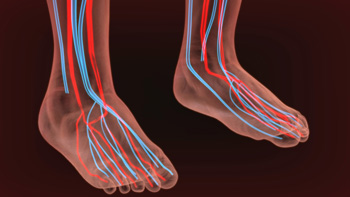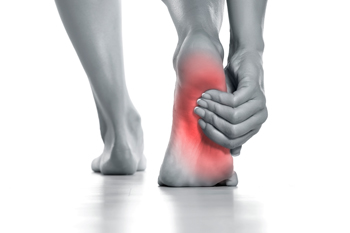
Poor foot circulation is a serious issue that can lead to various health complications if left untreated. Common warning signs include persistent coldness in the feet, even in warm environments. Numbness or tingling sensations, often described as pins and needles, can indicate circulation problems. Discoloration, such as a bluish or pale hue, may also be a sign of reduced blood flow. Swelling in the feet and ankles is another common symptom. Additionally, slow-healing sores or wounds on the feet can indicate poor circulation, as the necessary nutrients and oxygen are not efficiently reaching the area. Cramping or pain in the legs and feet, especially during physical activity, is another key indicator. Poor foot circulation can indicate serious health issues. If you have this condition, it is suggested that you visit a podiatrist who can determine what the reason is, and offer effective management tips.
While poor circulation itself isn’t a condition; it is a symptom of another underlying health condition you may have. If you have any concerns with poor circulation in your feet contact one of our podiatrists of Advanced Ankle & Foot Surgeons. Our doctors will treat your foot and ankle needs.
Poor Circulation in the Feet
Peripheral artery disease (PAD) can potentially lead to poor circulation in the lower extremities. PAD is a condition that causes the blood vessels and arteries to narrow. In a linked condition called atherosclerosis, the arteries stiffen up due to a buildup of plaque in the arteries and blood vessels. These two conditions can cause a decrease in the amount of blood that flows to your extremities, therefore resulting in pain.
Symptoms
Some of the most common symptoms of poor circulation are:
Treatment for poor circulation often depends on the underlying condition that causes it. Methods for treatment may include insulin for diabetes, special exercise programs, surgery for varicose veins, or compression socks for swollen legs.
As always, see a podiatrist as he or she will assist in finding a regimen that suits you. A podiatrist can also prescribe you any needed medication.
If you have any questions, please feel free to contact our office located in O'Fallon, IL . We offer the newest diagnostic and treatment technologies for all your foot care needs.

Dance, a beautiful art form, demands physical prowess and dedication, but it also comes with the risk of injury. Among the most common dance injuries are sprains and strains, which occur due to overstretching or sudden movements. Ankle sprains, in particular, are prevalent among dancers, often resulting from improper landings or sudden changes in direction. Stress fractures, caused by repetitive impact on the bones, are also common, especially in the feet and lower legs. Additionally, muscle tears and strains can occur from overexertion or sudden movements beyond the body's limits. Understanding these common dance injuries highlights the importance of proper training, warm-up routines, and rest periods to prevent overuse and minimize the risk of injury. If you enjoy dancing and have endured a foot or ankle injury, it is suggested that you consult a podiatrist who can effectively diagnose and treat these types of foot conditions.
Sports related foot and ankle injuries require proper treatment before players can go back to their regular routines. For more information, contact one of our podiatrists of Advanced Ankle & Foot Surgeons. Our doctors can provide the care you need to keep you pain-free and on your feet.
Sports Related Foot and Ankle Injuries
Foot and ankle injuries are a common occurrence when it comes to athletes of any sport. While many athletes dismiss the initial aches and pains, the truth is that ignoring potential foot and ankle injuries can lead to serious problems. As athletes continue to place pressure and strain the area further, a mild injury can turn into something as serious as a rupture and may lead to a permanent disability. There are many factors that contribute to sports related foot and ankle injuries, which include failure to warm up properly, not providing support or wearing bad footwear. Common injuries and conditions athletes face, including:
Sports related injuries are commonly treated using the RICE method. This includes rest, applying ice to the injured area, compression and elevating the ankle. More serious sprains and injuries may require surgery, which could include arthroscopic and reconstructive surgery. Rehabilitation and therapy may also be required in order to get any recovering athlete to become fully functional again. Any unusual aches and pains an athlete sustains must be evaluated by a licensed, reputable medical professional.
If you have any questions please feel free to contact our office located in O'Fallon, IL . We offer the newest diagnostic and treatment technologies for all your foot and ankle needs.

Endoscopic plantar fasciotomy, or EPF, is a surgical procedure used to treat plantar fasciitis. This painful foot condition is caused by inflammation of the thick band of tissue that runs along the bottom of the foot, known as the plantar fascia. During an EPF procedure, a small incision is made in the foot, and a thin, tube-like instrument called an endoscope is inserted to visualize the plantar fascia. Using specialized instruments, the podiatrist then cuts or releases the tight or damaged portion of the plantar fascia, relieving tension and reducing pain. Unlike traditional open surgery, EPF is minimally invasive and typically results in less postoperative pain, faster recovery times, and smaller scars. This procedure is often recommended for patients who have not responded to conservative treatments, such as rest, orthotic devices, or steroid injections. If you have plantar fasciitis, it is suggested that you are under the care of a podiatrist who can determine if this type of surgery is right for you.
Foot surgery is sometimes necessary to treat a foot ailment. To learn more, contact one of our podiatrists of Advanced Ankle & Foot Surgeons. Our doctors will assist you with all of your foot and ankle needs.
When Is Surgery Necessary?
Foot and ankle surgery is generally reserved for cases in which less invasive, conservative procedures have failed to alleviate the problem. Some of the cases in which surgery may be necessary include:
What Types of Surgery Are There?
The type of surgery you receive will depend on the nature of the problem you have. Some of the possible surgeries include:
Benefits of Surgery
Although surgery is usually a last resort, it can provide more complete pain relief compared to non-surgical methods and may allow you to finally resume full activity.
Surgical techniques have also become increasingly sophisticated. Techniques like endoscopic surgery allow for smaller incisions and faster recovery times.
If you have any questions please feel free to contact our office located in O'Fallon, IL . We offer the newest diagnostic and treatment technologies for all your foot and ankle needs.
 Feet endure a lot of stress, carrying our body weight over countless miles throughout a lifetime. This constant use can lead to various sources of foot pain, making even basic activities like walking painful. A common cause of foot pain includes plantar fasciitis, characterized by sharp heel pain due to inflammation of the tissue connecting the heel to the toes. Bunions, which are bony bumps forming at the base of the big toe, can also cause significant discomfort. Flat feet, where the arches collapse, can lead to pain and fatigue in the feet and legs. Additionally, arthritis can affect the joints in the feet, leading to chronic pain and stiffness. Treatments for foot pain vary depending on the cause but often include rest, compression, and elevation. Orthotic inserts and wearing proper footwear can also provide relief. In more severe cases, medical interventions such as corticosteroid injections or surgery may be necessary. If you are experiencing persistent foot pain, it is suggested that you see a podiatrist for a proper diagnosis and a tailored treatment plan.
Feet endure a lot of stress, carrying our body weight over countless miles throughout a lifetime. This constant use can lead to various sources of foot pain, making even basic activities like walking painful. A common cause of foot pain includes plantar fasciitis, characterized by sharp heel pain due to inflammation of the tissue connecting the heel to the toes. Bunions, which are bony bumps forming at the base of the big toe, can also cause significant discomfort. Flat feet, where the arches collapse, can lead to pain and fatigue in the feet and legs. Additionally, arthritis can affect the joints in the feet, leading to chronic pain and stiffness. Treatments for foot pain vary depending on the cause but often include rest, compression, and elevation. Orthotic inserts and wearing proper footwear can also provide relief. In more severe cases, medical interventions such as corticosteroid injections or surgery may be necessary. If you are experiencing persistent foot pain, it is suggested that you see a podiatrist for a proper diagnosis and a tailored treatment plan.
Foot Pain
Foot pain can be extremely painful and debilitating. If you have a foot pain, consult with one of our podiatrists from Advanced Ankle & Foot Surgeons. Our doctors will assess your condition and provide you with quality foot and ankle treatment.
Causes
Foot pain is a very broad condition that could be caused by one or more ailments. The most common include:
Diagnosis
To figure out the cause of foot pain, podiatrists utilize several different methods. This can range from simple visual inspections and sensation tests to X-rays and MRI scans. Prior medical history, family medical history, and any recent physical traumatic events will all be taken into consideration for a proper diagnosis.
Treatment
Treatment depends upon the cause of the foot pain. Whether it is resting, staying off the foot, or having surgery; podiatrists have a number of treatment options available for foot pain.
If you have any questions, please feel free to contact our office located in O'Fallon, IL . We offer the newest diagnostic and treatment technologies for all your foot care needs.